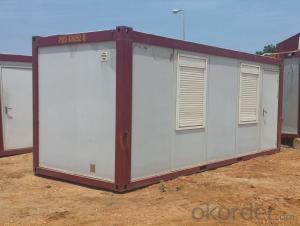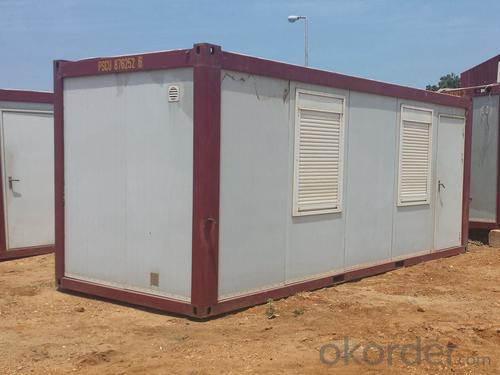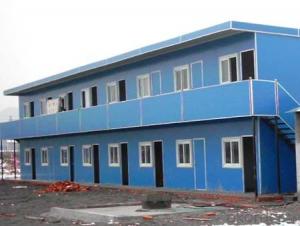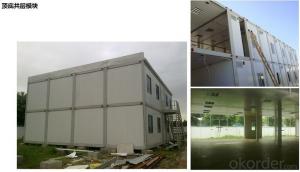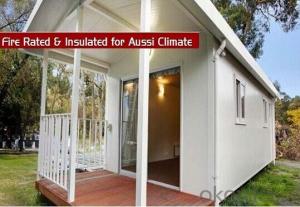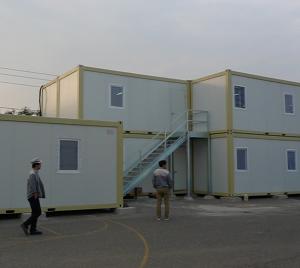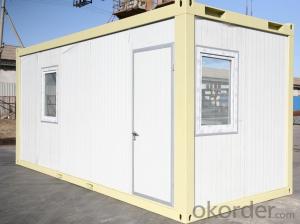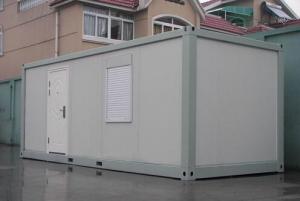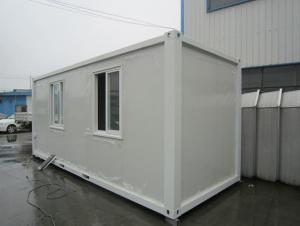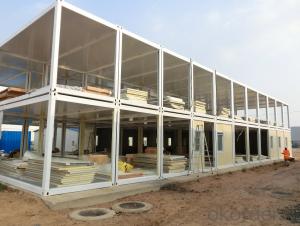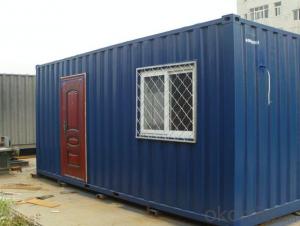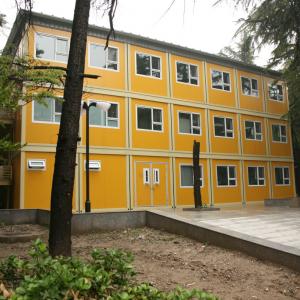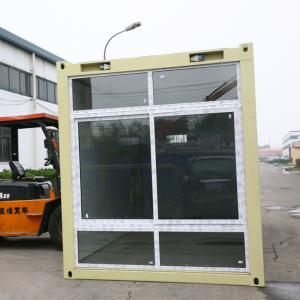Container Houses for Public Toliets of 20ft Size Exported to Africa
- Loading Port:
- Tianjin
- Payment Terms:
- TT OR LC
- Min Order Qty:
- 5 set
- Supply Capability:
- 10000 set/month
OKorder Service Pledge
OKorder Financial Service
You Might Also Like
Container Houses for Public Toliets of 20ft Size Exported to Africa
1. Brief Specification of Container Houses 20ft Public Toliet
1) Our container houses size list (mm)
TYPE | Outer size | Interior size |
Weight | ||||||
L | W | H(Pack) | H(Assembly) | L | W | H | |||
Standard | 20ft | 6055 | 2435 | 648/864 | 2591/2790 | 5880 | 2260 | 2510 | from 1850 |
Non-Standard | 10ft | 2989 | 2435 | 648/864 | 2591/2790 | 2815 | 2260 | 2510 | from 1200 |
Non-St | 16ft | 4885 | 2435 | 648/864 | 2591/2790 | 4730 | 2260 | 2510 | from 1750 |
Non-St | 24ft | 7296 | 2435 | 648/864 | 2591/2790 | 7160 | 2260 | 2510 | from 2300 |
Non-St | 30ft | 9120 | 2435 | 648/864 | 2591/2790 | 8945 | 2260 | 2510 | from 2470 |
2) Advantages
a. Quick production
b. Mobile house can be moved to another sites
c. Easy installation
d. Size is same so houses can be assembled to different layouts.
f. Use waterproof and fireproof materials
2. Main features of Container Houses 20ft Public Toliet
Container house specification | |
Length | 6055mm(inner 5851mm) |
Width | 2435mm(Inner 2260mm) |
Height | 2790mm(Inner 2510mm) |
Steel structure | Cold formed steel profiles in a thickness of 3mm to 4mm(bottom rails) |
Wall panel | 9mm chipboard panel, 60mm mineral wool, 0.5 steel sheet |
Roof panel | 100mm rock wool |
Outside door | 40mm sandwich door with aluminum frame size 830mm*2030mm |
Inside door | Sandwich door |
Window | PVC sliding window size 800*1100mm; with PVC mosquito net and PVC rolling shutter |
Heat Insulation | Mineral wool |
Electricity and Water System | Providing design |
Feature | Can be transported by truck and assembled very fast at site, easy to move anytime |
Floor | Gray PVC flooring, 20mm plywood |
Ceiling | 9mm chip wood panel |
Shipment | 4 units can be connected into one bundle which can be shipped same as one 20' GP |
Bearing load | 2.5 KN/m2 |
Life span | 20 to 25 years |
Remarks | This specification is for the reference, if there are differences between actual condition, the adjusting is according to the actual condition.
|
3. Pictures of Container Houses 20ft Public Toliet
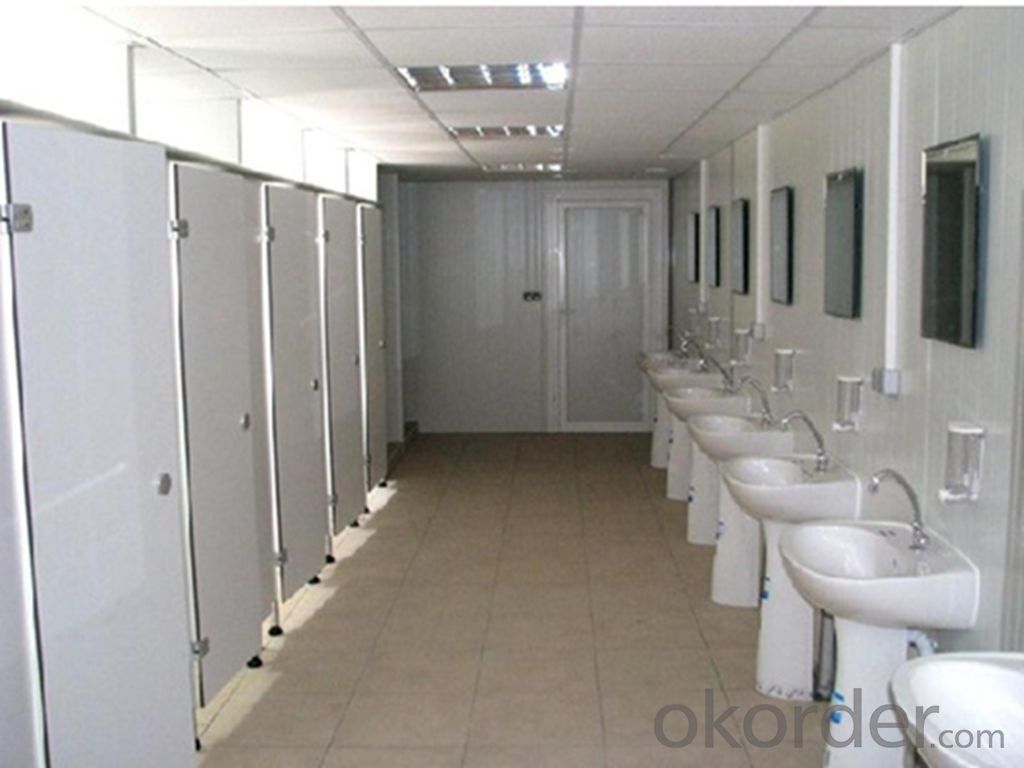
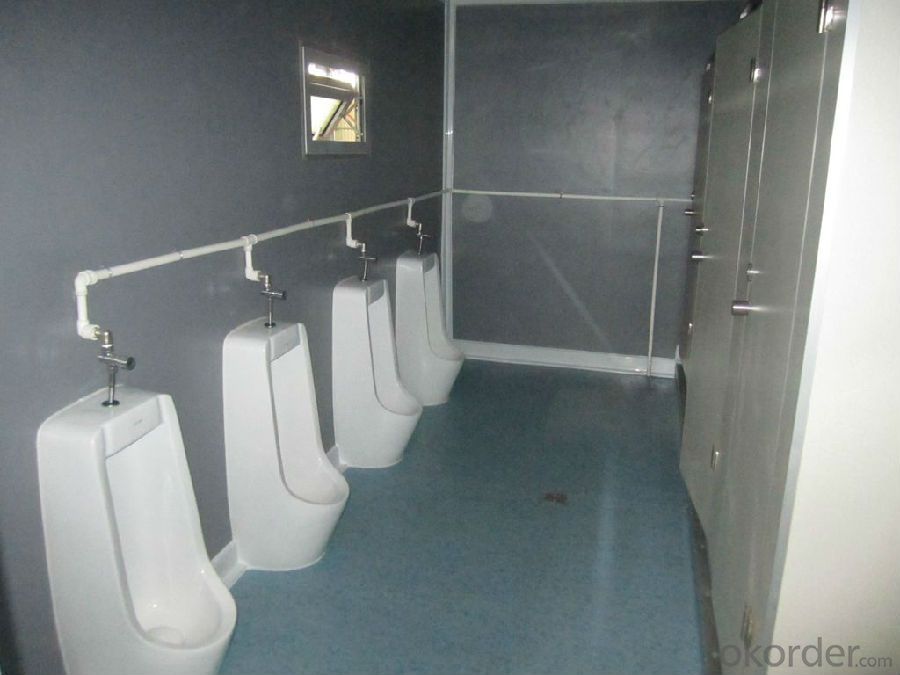
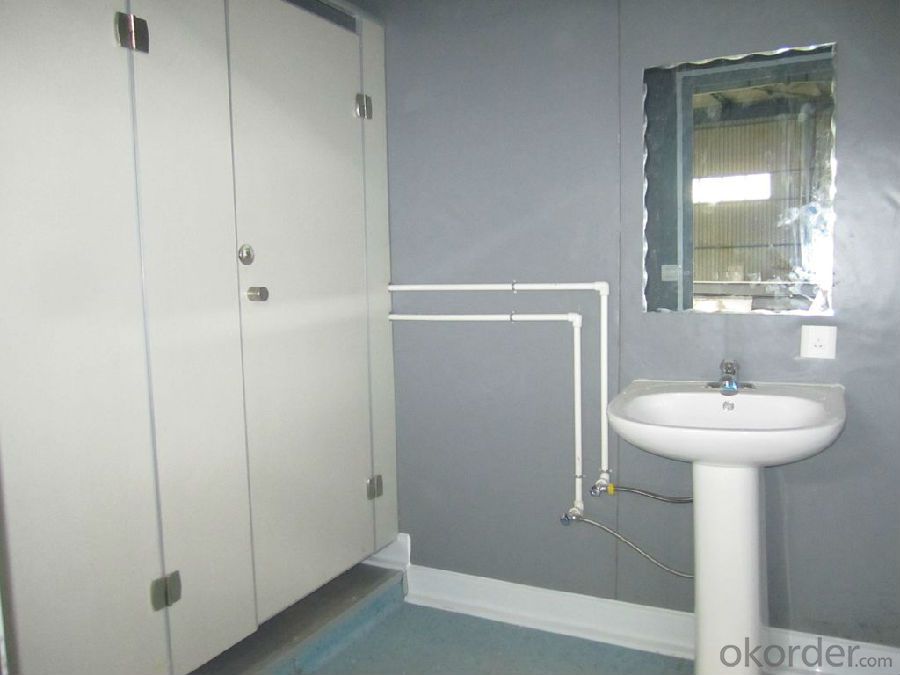
4. Main Materials of Container Houses 20ft Public Toliet
Panels for wall and roof
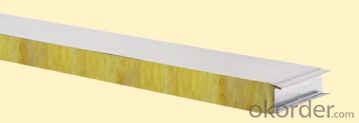
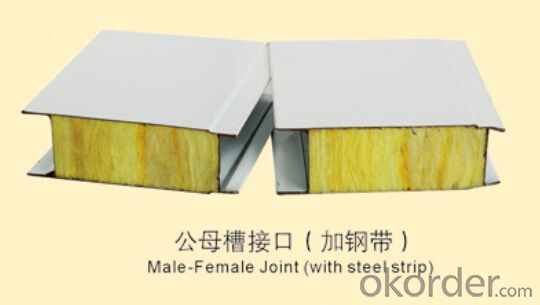
Steel Frame Galvanized and Painted
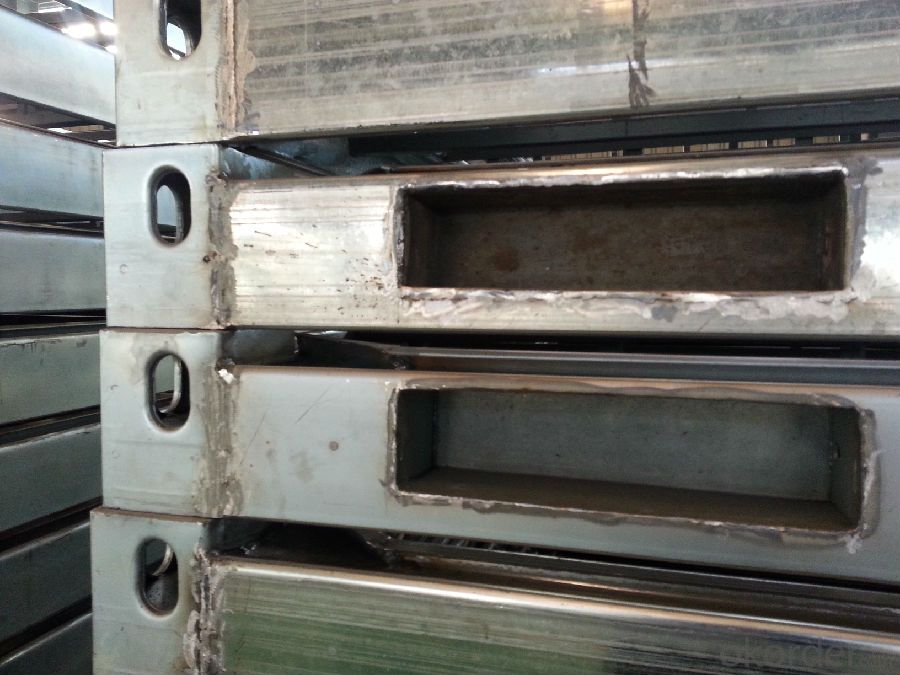
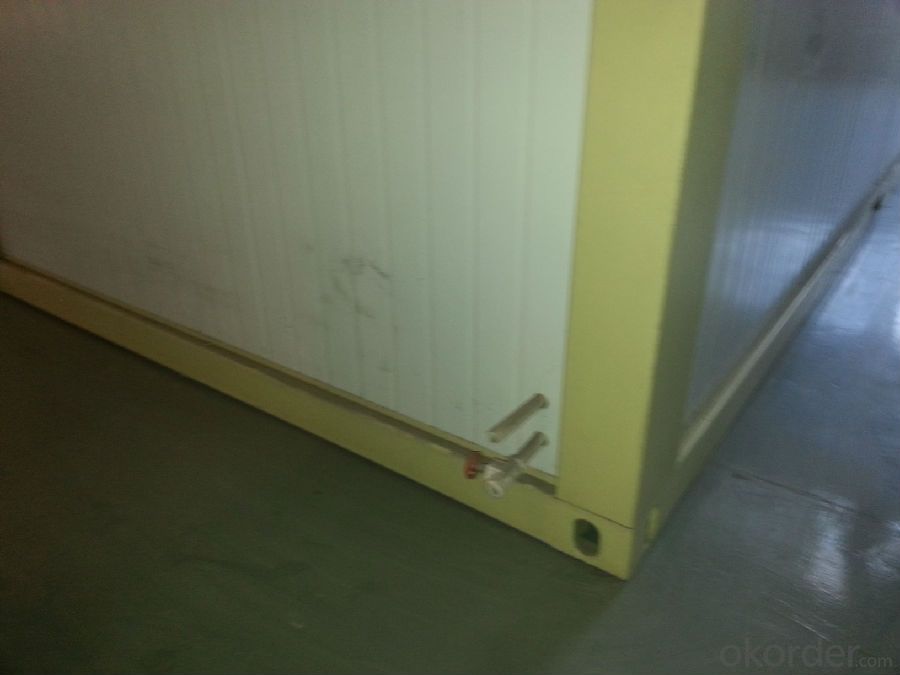
Windows and Doors

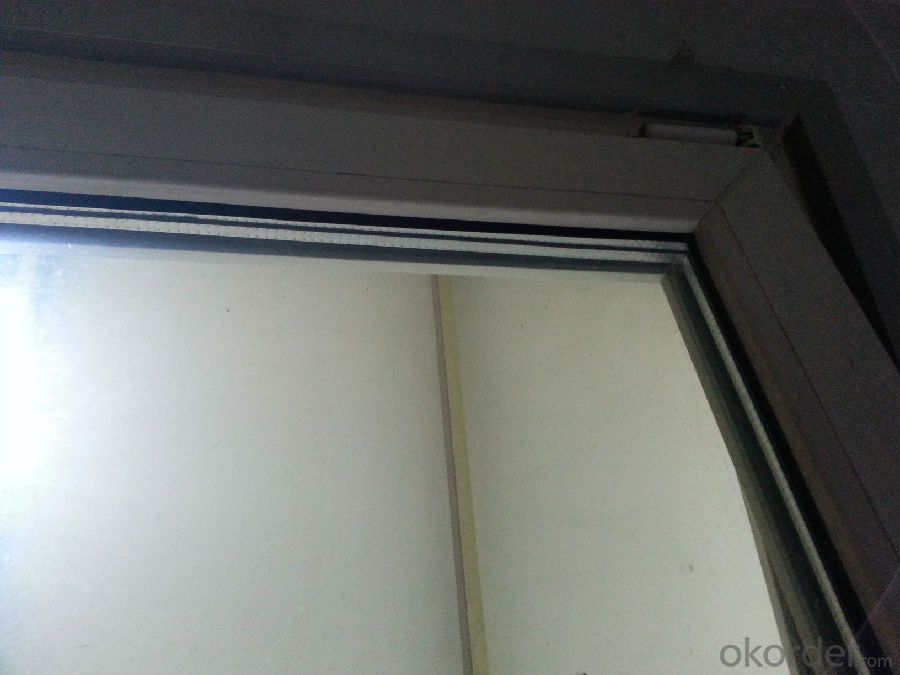
5. FAQ of Container Houses 20ft Public Toliet
1. Q: How much is this house?
A: Please provide with your house drawing and project location, because different design, different location effect the house materials quantity and steel structure program.
2. Q: Do you do the turnkey project?
A: Sorry, we suggest customer to deal with the foundation and installation works by self, because local conditions and project details are well knowb by customers, not us. We can send the engineer to help.
3. Q: How long will your house stay for use?
A: Our light steel prefab house can be used for about 30 years.
4. Q: How long is the erection time of one house?
A: for example one set of 20ft container house, 2 workers will install it within 4 hours.
5. Q: Can you do the electricity,plumbing and heater?
A:The local site works had better to be done by the customers.
- Q: Are container houses suitable for areas with limited sunlight?
- Container houses can be suitable for areas with limited sunlight, as they can be designed and modified to maximize natural light. Skylights, large windows, and reflective surfaces can be incorporated to ensure sufficient interior illumination. Additionally, alternative energy sources such as solar panels can be used to offset the limited sunlight and provide the necessary power for lighting and other electrical needs.
- Q: Are container houses suitable for low-income housing projects?
- Container houses are indeed a viable option for low-income housing endeavors. Due to their utilization of recycled shipping containers, they prove to be cost-effective, resulting in reduced construction expenses. This enables swifter implementation of these projects, catering to the urgent requirement for low-income housing. Moreover, container houses demonstrate flexibility, easily adaptable to meet the distinctive necessities and preferences of various communities. They can incorporate vital facilities such as plumbing, electricity, and insulation, thus ensuring a secure and comfortable living environment for those with limited financial resources. Furthermore, container houses contribute to environmental sustainability by repurposing existing materials, making them eco-friendly. Ultimately, container houses provide an economical and pragmatic solution for low-income housing initiatives, rendering them a suitable choice to tackle the housing needs of underprivileged communities.
- Q: Are container houses suitable for individuals who enjoy outdoor living?
- Container houses are indeed a suitable choice for those who relish the outdoor lifestyle. By incorporating sizable windows and open floor layouts, container houses enable an abundance of sunlight to filter in, thereby establishing a harmonious link between the interior and exterior spaces. Furthermore, container houses lend themselves to effortless customization and modification, permitting the inclusion of outdoor decks, patios, or even rooftop gardens, thus maximizing opportunities for outdoor living. With thoughtful design, container houses seamlessly merge indoor coziness with outdoor delight, rendering them an excellent alternative for individuals who have a passion for the great outdoors.
- Q: Can container houses be designed as weekend getaway homes?
- Yes, container houses can definitely be designed as weekend getaway homes. In fact, they are becoming increasingly popular for this purpose. Container houses offer several advantages that make them ideal for weekend getaways. Firstly, container houses are highly customizable, allowing you to design and create a unique space that suits your specific needs and preferences. With the right design and layout, you can transform a container into a cozy and comfortable weekend retreat. Secondly, container houses are relatively affordable compared to traditional homes or vacation properties. Containers can be purchased at a lower cost and converted into livable spaces at a fraction of the price of a conventional house. This affordability makes them an attractive option for those looking for a budget-friendly getaway home. Additionally, container houses are portable and easy to transport. This means that you can easily relocate your weekend getaway home to different locations, allowing you to explore new areas and enjoy different experiences. It also gives you the flexibility to move your getaway home to a more suitable location based on the season or personal preferences. Furthermore, container houses are eco-friendly. By repurposing shipping containers, you are effectively recycling and reducing waste. Additionally, container homes can be equipped with energy-efficient features such as solar panels, rainwater harvesting systems, and energy-saving appliances, making them environmentally sustainable options for a weekend retreat. Lastly, container houses can be designed to provide all the necessary amenities for a comfortable getaway experience. From bedrooms and bathrooms to kitchens and living areas, containers can be transformed into fully functional living spaces. With proper insulation and ventilation, container houses can offer the same level of comfort as traditional homes. In conclusion, container houses can be excellently designed as weekend getaway homes. They offer customization options, affordability, portability, sustainability, and the ability to provide all necessary amenities. With the right design and planning, container houses can provide a unique and enjoyable weekend escape.
- Q: Can container houses be designed to have a pet-friendly layout?
- Yes, container houses can definitely be designed to have a pet-friendly layout. There are several key factors to consider when designing a container house with pets in mind. Firstly, it is important to ensure that there is enough space for pets to move around comfortably. Containers can be modified to create larger living areas or multiple levels, allowing for more room for pets to play and explore. Secondly, it is crucial to incorporate pet-friendly materials and finishes into the design. Opting for durable and pet-friendly flooring materials such as laminate, tile, or vinyl will make it easier to clean up any accidents or messes. Additionally, using scratch-resistant materials for walls and furniture can help prevent damage caused by pets. Furthermore, including designated spaces for pets within the house is essential. This might involve incorporating built-in pet beds or crates, as well as creating dedicated play or exercise areas. These designated spaces will provide pets with a sense of ownership and comfort within the home. Additionally, ensuring ample natural light and ventilation in the house is important for the well-being of pets. Including large windows or skylights can provide pets with a view of the outside world and allow for natural airflow, creating a healthier environment for them. Lastly, it is crucial to consider the safety of pets within the container house. This may involve installing pet-friendly gates or barriers to prevent access to certain areas, as well as securing windows and balconies to prevent accidents or escapes. In summary, container houses can be designed to have a pet-friendly layout by considering factors such as space, materials, designated areas, natural light, ventilation, and safety. With careful planning and design, container houses can provide a comfortable and enjoyable living experience for both humans and their furry friends.
- Q: How are container houses different from traditional houses?
- Container houses, also known as shipping container homes, are unique and distinct from traditional houses in several ways. Firstly, the construction process differs significantly. While traditional houses are built using conventional materials such as bricks, wood, and concrete, container houses are constructed from repurposed shipping containers. These containers are made of steel, making them sturdy and durable. Secondly, container houses are more cost-effective compared to traditional houses. The use of shipping containers significantly reduces the construction costs as containers are readily available and relatively inexpensive. Moreover, the construction time is reduced as container houses can be prefabricated and assembled on-site, resulting in lower labor costs. Another notable difference is the flexibility and versatility of container houses. Traditional houses are generally fixed structures, whereas container houses can be easily modified, expanded, or relocated. The modular design of shipping containers allows for more flexibility in the layout and design of the living space. This adaptability makes container houses a popular choice for those seeking a more customizable and unique living environment. Furthermore, container houses are considered more environmentally friendly compared to traditional houses. By repurposing shipping containers, these homes contribute to recycling and reducing waste. Additionally, container houses often incorporate sustainable features such as solar panels, rainwater harvesting systems, and energy-efficient insulation, making them more eco-friendly and energy-efficient. In terms of aesthetics, container houses can have a modern and industrial look due to their steel structure. However, with creative designs and exterior finishes, they can also resemble traditional homes. This versatility in appearance allows homeowners to choose a style that suits their preferences. In summary, container houses differ from traditional houses in terms of construction materials, cost-effectiveness, flexibility, environmental impact, and aesthetic options. These unique characteristics make container houses an attractive and innovative alternative for those seeking a more affordable, sustainable, and customizable housing solution.
- Q: Are container houses suitable for coastal areas?
- Indeed, coastal areas can indeed be a suitable location for container houses. These houses are constructed using shipping containers, which are made of robust steel and designed to withstand harsh weather conditions, including the challenging coastal environment characterized by strong winds, saltwater exposure, and the possibility of flooding. One of the key advantages of container houses is their steel structure, which renders them highly resistant to corrosion caused by saltwater, a common issue in coastal regions. Additionally, the compact design of these houses allows for easy transportation and installation, making them an ideal choice for coastal areas where building sites may be limited or difficult to access. Moreover, container houses can be specifically designed to be elevated on stilts or pilings, offering enhanced protection against potential coastal flooding and increasing their resilience in the face of rising sea levels. This feature proves especially beneficial in coastal areas prone to storms, hurricanes, or tsunamis. Furthermore, container houses in coastal areas contribute to sustainability efforts. The practice of repurposing shipping containers for housing purposes reduces waste and minimizes the environmental impact of construction. Additionally, these houses can be equipped with energy-efficient systems and materials, such as solar panels and insulation, reducing their carbon footprint and providing a sustainable living option in coastal regions. To summarize, container houses are a suitable housing solution for coastal areas due to their durability, resistance to saltwater corrosion, adaptability to various terrains, and sustainable construction practices. They offer a viable and resilient option that can withstand the unique challenges presented by coastal environments.
- Q: Are container houses suitable for minimalistic living?
- Yes, container houses are indeed suitable for minimalistic living. Their simple and compact design aligns well with minimalistic principles of decluttering and living with less. Container houses offer a functional and practical living space that encourages a minimalist lifestyle by providing just the essentials, promoting sustainable living, and reducing the need for excessive material possessions.
- Q: Can container houses be designed to have a spacious kitchen area?
- Absolutely, it is entirely possible to design container houses with a generous kitchen area. Although container homes typically have less square footage compared to traditional houses, there are various ways to maximize the kitchen space through imaginative design and space-saving techniques. One strategy involves adopting an open-concept layout, eliminating unnecessary walls and partitions to create a larger area. By integrating the kitchen with the living or dining space, the overall room can feel much more expansive. Additionally, optimizing the available space can be achieved by utilizing multi-functional furniture and storage solutions. For instance, incorporating kitchen islands with built-in storage or foldable countertops can provide additional workspace when required. Wall-mounted shelves and cabinets can also be utilized to maximize vertical storage, ensuring the kitchen area remains uncluttered. Moreover, the strategic positioning of windows and the infusion of natural light can create a more open and airy ambiance. Installing sizable windows or skylights can introduce an abundance of natural light, thereby making the kitchen space appear more expansive and inviting. Lastly, the selection of an appropriate color palette and materials can greatly contribute to the perception of a larger kitchen area. Lighter colors such as whites, neutrals, or pastels can impart a brighter and more spacious feel. Additionally, incorporating reflective surfaces like glass or mirrors can create an illusion of depth and roominess. By making thoughtful design choices and embracing innovative solutions, container houses can undoubtedly feature a spacious kitchen area that caters to the needs and preferences of homeowners.
- Q: Can container houses be designed to have a small balcony or terrace?
- Absolutely, container houses can be designed with a charming balcony or terrace. Although shipping containers are typically used as the primary structure, the design possibilities are boundless. Balconies or terraces can be incorporated into container houses to expand the living area and offer outdoor spaces. There are various design approaches to creating a small balcony or terrace in a container house. One option is to remove a section of the container wall and replace it with large sliding or folding glass doors that open onto a balcony. This allows for a seamless integration of indoor and outdoor living, enhancing the perception of space. Another approach involves utilizing the container house's roof as a terrace. By strengthening the roof structure and adding safety features like railings, a practical outdoor space can be fashioned. This rooftop terrace can be accessed through an external staircase or even an internal one within the container house. When designing a balcony or terrace for a container house, it is crucial to take into account structural integrity and weight distribution. To ensure the structure's safety and stability, it may be necessary to incorporate proper support systems such as additional steel beams or columns. Moreover, careful consideration should be given to the choice of materials for the balcony or terrace, as they must withstand outdoor elements. Durable and weather-resistant materials like composite decking or concrete can be used to create a functional and visually appealing outdoor space. In conclusion, container houses can absolutely include a small balcony or terrace. By meticulously planning, making structural adjustments, and using suitable materials, container houses can offer a delightful and comfortable outdoor living experience.
Send your message to us
Container Houses for Public Toliets of 20ft Size Exported to Africa
- Loading Port:
- Tianjin
- Payment Terms:
- TT OR LC
- Min Order Qty:
- 5 set
- Supply Capability:
- 10000 set/month
OKorder Service Pledge
OKorder Financial Service
Similar products
Hot products
Hot Searches
Related keywords
